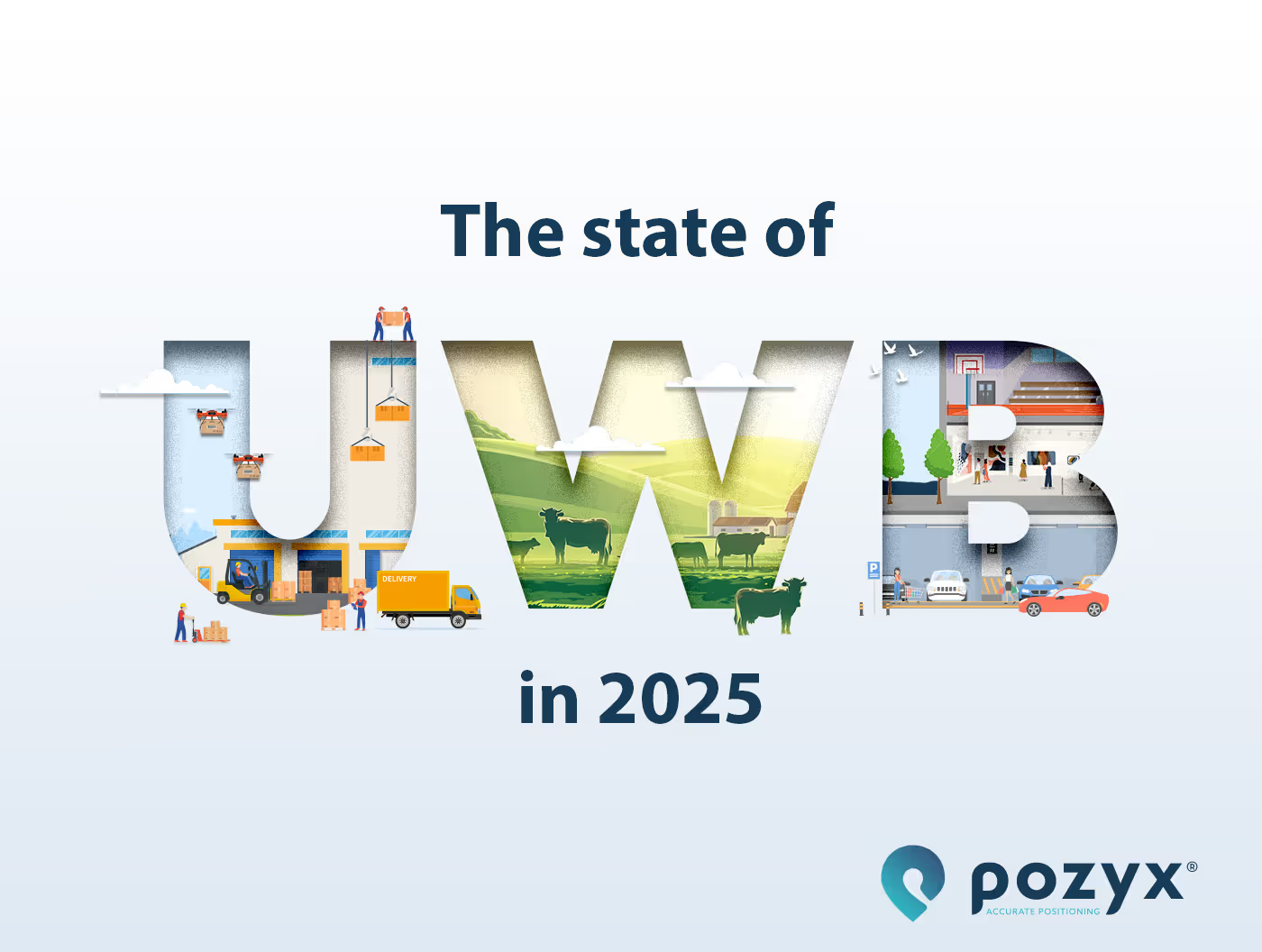The State of UWB in 2025
UWB technology (ultra-wideband) has been around for many years, but until just a few years ago, it was still a niche technology and only adopted by a small number of pioneering companies. Recent market growth numbers show a steep increase in UWB’s success being adopted in consumer products like smartphones, smartwatches, smart home devices, as well as in automotive and in industrial real-time location systems (RTLS).
Today, ultra-wideband (UWB) is at the tipping point of mass adoption across multiple industries. By 2025-2026, we expect UWB to evolve beyond its current use cases in smartphones, automotive, and RTLS into more advanced, high-precision applications with greater global adoption.
UWB has been acknowledged and praised for its technical capabilities and benefits. However, this alone does not guarantee the wide adoption of a technology. In this post we cover the different non-technical aspects that are foundational to the commercial success of the technology.
In this overview we'll cover:
1. Main applications of ultrawideband technology
Below, we list the three major applications of UWB in 2025.
UWB in consumer products

By far the largest adoption of UWB has been seen in consumer products, primarily in the smartphone market. In 2024, approximately 60% of all UWB chips shipped were embedded in a smartphone. Apple is clearly leading the way and has added UWB capabilities to a host of consumer products in its ecosystem to support so-called ‘spatial awareness’ for their devices. However, other major smartphone vendors like Samsung and Xiaomi have followed suit to adopt UWB in their flagship models.
At the basis of this is the FiRa Consortium (Fine Ranging) which is dedicated to transforming the way we interact with our environment by enabling precise location awareness for people and devices. The FiRa consortium has developed a standard that describes a common set of protocols to enable applications such as physical access control, smart home, indoor navigation, social distancing, or asset tracking.
In 2024, we saw a lot of new chipsets supporting and being certified for Fira v2.0, which enables many more use-cases as compared to version 1.0. It is therefore expected that we’ll see a wide range of new consumer products coming to market taking advantage of these newly available chips. Especially in the market for smart locks we expect some new products coming to market taking advantage of UWB accuracy and security resulting in an improved experience using these systems with your smartphone.
UWB in industrial RTLS
By nature of the accurate ranging capabilities of UWB, the technology has been an obvious technology for Real-time location systems. With UWB technology, RTLS systems can provide real-time positioning with an accuracy of 10 to 30cm even in the most challenging environments. UWB RTLS is primarily utilized in the mining industry, manufacturing, distribution but also in healthcare, agriculture, retail or even sports.
Before UWB became a mainstream technology due to the smartphone adoption, UWB RTLS was the main use-case driver for the technology. However, adoption of the technology in RTLS has been much slower as compared to the fast pace of consumer products. Adoption in an industrial context tends to be a slow and incremental progress. However, the days that UWB still had to prove itself as a reliable technology in challenging environments have past. Today, UWB RTLS is considered the golden standard for accurate indoor positioning.
Around the same time that FiRa started in 2019, another standard emerged called the Omlox standard. This standard was specifically aimed for industrial RTLS applications to provide interoperability in between RTLS system vendors, as well as RTLS (software) applications. While the initial version of the standard was never brought to market, the latest version of Omlox (released in 2023) now slowly paves the way for wider adoption of the standard.
UWB in automotive
Automotive is another (upcoming) application domain for UWB where the technology is embedded in the vehicles to support a range of functionalities. Major manufacturers such as BMW, Mercedes, Volkswagen, GM and Tesla have already launched vehicles with UWB, or are actively working on it. In 2024, about 6% of cars were shipped were so-called UWB-enabled. A percentage that is expected to grow to 40% by 20230.

The ‘smart entry’ functionality, which intelligently locks and unlocks a vehicle based on the location of the car key, is a major driver for the technology. However, the upcoming regulation for child presence detection(CPD) could potentially become an even bigger driver for UWB technology. To support this capability, UWB ranging will not suffice and will have to rely on the UWB radar capabilities for which an array of new chips will be launched to market.
At the basis of the adoption is again an international standard. More notably, the Car Connectivity Consortium (CCC), which has standardized the UWB protocols to be used to support interoperability between car keys from different car manufacturers. In 2024, NXP Semiconductors and BMW Group were announced as the first companies to receive CCC digital key interoperability and security certifications, with more to follow.
Stay in the loop!
Stay up to date with the latest Pozyx and Industry news on Real-Time Location Tracking. Don’t miss out! No spam, promise.
Yes, sign me up
2. UWB chip interoperability
IEEE standard
Wireless applications prosper best within the sphere of industry standards. Standards offer the freedom to purchase from a larger pool of suppliers, competitive pricing, a common technology that eases design decisions and inventory requirements, and most importantly, standards allow devices or chips from different vendors to interoperate, creating a truly future-proof solution.
The benefits of communication standards are important for large technology and consumer electronics companies to guarantee the lowest cost and continuity of supply, thereby avoiding the single-source trap. This ‘peace of mind’ aspect is the main blessing of standards that makes large companies big supporters. Furthermore, a standard is usually based on a collective experience and cooperation which increases reliability and long-term availability. A good standard also creates an ecosystem of multiple vendors (competing on quality and price), all helping to further bolster UWB adoption and future-proofing.
IEEE 802.15.4 standard versions have impacted UWB
IEEE has recognized the need to standardize UWB technology for use in personal area networks (PANs). It has established the IEEE 802.15.4a, released in 2007, the first standard to include UWB and to define both the MAC (link layer) and PHY (physical layer) within the OSI model (which defines the 7 layers of network architecture). These additions introduced new features that the previous 802.15.4 standard was lacking to be able to support UWB: higher data throughput and precise ranging. The next standard versions IEEE 802.15.4-2011 and IEEE802.15.4-2015 were released to enable backward compatibility and introduce both the LRP & HRP (low rate pulse & high rate pulse) UWB PHY. This version is still used in many of the commercially available UWB devices today.
In August 2020, the IEEE 802.15.4z was released with a focus on enhanced ranging capabilities, high increase of security, and enhanced power consumption, indeed all characteristics needed to further enhance and optimize UWB solutions. The next expected release is planned for 2025 with version IEEE 802.15.4ab. It will support new rule sets to expand use cases, new smartphone features such as streaming audio, increased security through smaller packages, and significantly lower power.
As a conclusion, the IEEE standard not only crafts stability and interoperability, it also propels the UWB feature set that translates into benefits from which the UWB devices and their applications can prosper.
3. Ultra wide band regulations
The clear definitions from the IEE802.15.4 standard specify three frequency bands, yielding 16 radio channels in total. Regulation has followed and every country’s regional regulatory authorities define which of these bands can or cannot be used geographically, resulting in well-defined UWB regulations. The new generation of UWB chipsets allows new regions, such as Japan, to be covered with the same technology. For the consumer applications, UWB channels 5 (at 6GHz) and 9 (at 8GHz) have been selected by FiRa as the main UWB channels to be used as they allow global usage.
UWB RTLS applications still tend to use the lower frequency channels as they provide the highest possible range with UWB technology, which directly impacts the amount of infrastructure needed for an RTLS installation. However, future systems will likely also adopt UWB channel 9 to be used in certain geographies such as Japan and China. Furthermore, UWB channel 5 is increasingly being challenged ever since WiFi was allowed to utilize the same frequency band resulting in interference with any UWB system. Currently WiFi at 6GHz (introduced in Wifi 6E) is still limited in its adoption, but it is expected to grow in the coming years.
Recent changes to UWB regulation
In 2024, the European Union updated UWB regulations to enhance the technology’s adoption and performance. Implementing Decision (EU) 2024/1467, adopted on May 27, amended previous rules to harmonize spectrum use across the Union. Key changes included increasing indoor UWB transmission power by 10 dB, from -41.3 dBm/Hz to -31.3 dBm/Hz, extending operational range. The update also permitted certain outdoor applications, such as location tracking and vehicular use, benefiting real-time location systems (RTLS) in industries needing extended range and outdoor functionality. This change is a major step forward for UWB in EU and similar discussions are ongoing for US, although no clear decision has been made yet.
China also has introduced significant changes to its UWB regulations. On April 29, 2024, the Ministry of Industry and Information Technology (MIIT) issued the "Interim Provisions on the Radio Management of Ultra-Wideband (UWB) Radio Transmission Equipment" (MIIT No. 77 [2024]), set to take effect on August 1, 2025, replacing the 2008 guidelines. The new rules define UWB equipment as having a transmission bandwidth of at least 500 MHz, operating within 7163-8812 MHz, effectively banning lower frequency channels and pushing most systems to use UWB channel 9.
Upcoming changes to UWB regulation
As stated, discussions are ongoing to also modernize the UWB regulation in US. Additionally, 2027 will be a pivotal year for UWB with the World Radiocommunication Conference (WRC). Since decisions made at WRC affect wireless communications worldwide, the conference is a critical event for shaping future spectrum policies, impacting technologies like 5G, satellite broadband, and ultra-wideband (UWB) applications. 5G's consideration to utilize high-band spectrum will be discussed and are of particular interest to UWB, as they could directly impact the upper UWB channels.
Instances like the UWB Alliance help to support UWB adoption by actively voicing the concerns and recommendations of all UWB stakeholders towards the regulators of various countries.
4. UWB chip ecosystem
With the standardization maturing to guarantee future-proof solutions, it was Decawave (currently Qorvo) to release the first commercial UWB radio chip in 2013 to support the IEEE 802.15.4 - 2015 version, which is still heavily used in RTLS and IOT applications.
The most recent IEEE 802.15.4z, optimized for consumer applications and released at the end of 2020 is supported today by various semiconductor vendors: Qorvo, NXP, Apple, producing its own U1 and U2 UWB chips (the “U” stands for UWB), ST Micro, Qualcomm and imec have all invested heavily in the development of UWB chips. In 2024, various Chinese semiconductor vendors released UWB chips as well resulting in a broad selection of UWB chip providers.
In 2024, close to 450 million UWB chips were shipped, an increase of 21% year over year, as estimated by TechnoSystemsResearch. Other than the expansion in smartphone, consumer tags, and automotive digital key caused market growth during 2024.
UWB is on the verge of becoming the next essential component technology, like GPS, WiFi and Bluetooth before it. Already shipping in millions of smartphones and cars, and across more than 40 other verticals, UWB is enabling accurate indoor location services, secure communications, context-aware user interfaces and advanced analytics, making it ideally suited to Industry 4.0 applications.
Eric Creviston, President of Qorvo
It is clear that the landscape of UWB chips available for commercial use is rapidly expanding. Each of the vendors has developed radio chips to support specific IEEE 802.15.4 standard versions and the different standard alliances (applications) that operate in different communication channels. The succeeding chipset product development cycles result in lower power consumption, smaller form-factor, and support for a broader range of features.
Technologies will never become globally successful when based on an exclusive offering. The industry adoption is fueled by the variety of semiconductor offerings to choose from to allow competition (on specs and features) to avoid the much-loathed vendor lock-in and to allow future interoperability between different UWB devices. And obviously, as the production of UWB chips continues to ramp up over time it holds the promise of a lower price.
5. Ultra wide band application standardization
Multiple standards have been defined for UWB communication. Apart from the technical standard IEEE 802.15.4, several standardization bodies, each with their specific focus, business scope and goals, operate to bring standardization to UWB. Technologies only endure when they are backed by a robust, quality-driven infrastructure that enables rapid expansion, providing a favorable regulatory and spectrum management landscape to secure and maximize UWB growth.

FiRa Consortium
The FiRa Consortium, originally focusing on peer-to-peer applications between smartphones and various (consumer) devices. To date, the FiRa Consortium boasts more than 100 members across various categories. Among the initial sponsor members were ASSA ABLOY Group (HID Global), NXP Semiconductors, Samsung Electronics, and Apple.
Early in January 2025, FiRa released its latest specification v3.0, about one year after the previous version 2.0. The new Core v3.0 enhances the efficiency and versatility of its UWB systems which would allow multiple use-cases (such as tracking and keyless entry) to operate more efficiently at the same time. The new release also adds the CCC Digital Key UWB feature for more interoperability with the CCC standard.
In 2024, various new UWB radio chips passed FiRa v2.0 certification including chips from NXP, Qualcomm, GiantSemi, Chipsbank, Maxscend, and NewRadioTech.
Omlox Consortium

Omlox is an open standard for Real-Time Location Systems (RTLS). The Omlox standard is managed by the PI organization, which also managed popular industrial standards such as Profibus, Profinet and IO link. To date, the Omlox standard brings together over 60 partners and members including Qorvo, STMicroelectronics, Amazon AWS, Siemens, and Pozyx. Over 300 professional use-cases have been defined, primarily in Production, Logistics, process industry, healthcare and retail.
The Omlox consortium has developed two standards:
- Omlox Core zone: A standard for UWB location systems defining how tags and infrastructure communicate in order to allow interoperability between RTLS tags and anchors of different vendors.
- Omlox hub: A standardized interface for retrieving location information from a wide variety of localization techniques, such as UWB, RFID,5G, BLE, WiFi, and GPS.
Both standards are currently in version 2.0, which were released in 2023. Early 2025, Omlox will finalize its official certification program for both the core zone and the hub.
Car Connectivity Consortium
The Car Connectivity Consortium, also CCC, is dedicated to bringing automotive and consumer technology industries together to future-proof vehicle access using smart-devices. The consortium has over 300 members companies collaborating to develop global standards and solutions for smart-devices and in-vehicle connectivity while reducing market fragmentation of our technologies. Some notable members are Apple, Google, NXP as well as a large amount of major car manufacturers.
The CCC utilizes a variety of technologies such as BLE, UWB and NFC in order to provide reliable solutions. The latest Car Key version 3 v1.1 was released in 2022. Since then, several plug-fests have been organized to bring together different car and smartphone manufacturers to test and demonstrate the use and interoperability of the UWB-driven keys. In December 2023 the CCC launched its certification program which NXP and BMW the first to achieve the certification in 2024.

The future will tell which of these standards will win the market but for now, it seems that their focus is clearly defined in different application spaces and different feature sets in order not to compete. To date, the FiRa consortium has picked up the most speed as it drives the biggest volume of UWB chip sales. The Omlox standard is yet to prove itself as the initial version was limited as a proof-of-concept. With Omlox version 2.0, we will finally see Omlox certified products hitting the market in the next years.
Given that the different standards cater to different use-cases, it may be that they will forever exist next to each other. As we are seeing, these standards are coming closer to each other in order to guarantee coexistence of the different standards or potential combined use-cases. An example of this is the inclusion of the CCC Digital Key into the latest FiRa standard. Similarly, a liaison between FiRa and Omlox was initiated in 2023 and has resulting in the creation of a joint working group in 2024.
6. Recent advancements on UWB and outlook for 2024
The year 2024 has been an important year for UWB which saw many new UWB chipsets becoming available, updated regulations in EU and China, and an update to the FiRa standard, which drives the most significant volume of UWB chips. Market research reports indicate that UWB chip sales increased to 450 to 500 million units. It is expected that 2025 will again show meaningful growth with new products coming to market, taking advantage of the new chipsets.
For 2025 we don’t expect major changes regarding regulations as this will likely happen in 2027 after the World Radiocommunications Conference. Recent changes in the European regulation can potentially increase the viability of UWB RTLS applications as range can be increased and outdoor usage will now become permitted.
In the longer term we can see increased attention to UWB radar which would allow presence and health detection of people without requiring them to carry any electronics. This has some applications in automotive for child presence detection, but also in smart home devices. Furthermore, with the upcoming new IEEE 802.15.4ab in 2025, we will see new generation of UWB chips hit the market with further reduced power consumption, increased security and novel support for streaming audio. Regarding application standards, we may see increased collaboration in between the different standards given that they are to a large extent very complimentary. Whether or not that will succeed, only time will tell.
By 2025-2026, we expect UWB to transition from a specialized technology to a core connectivity standard, much like WiFi and Bluetooth today. With major regulatory improvements, expanding ecosystems, and widespread industry adoption, UWB is set to reshape location-based services, automation, and security.

Written by
Samuel Van de Velde
CTO & Co-Founder at Pozyx
Samuel is an electrical engineer with a strong interest in location technology. Skilled in Entrepreneurship, Public Speaking, Product Management, internet of things (IoT), and Machine Learning. After graduating In 2010, he joined the Department of Telecommunications and Digital Information Processing (TELIN) to pursue a Ph.D. degree on the topic of collaborative indoor localisation. In 2015, he founded the spin-off company Pozyx out of that research.









